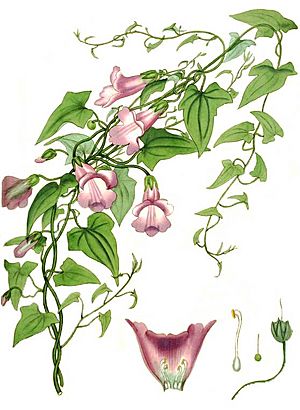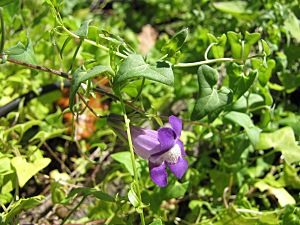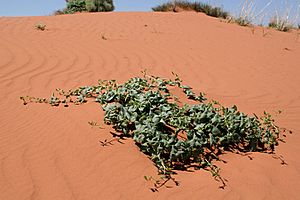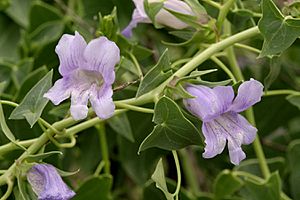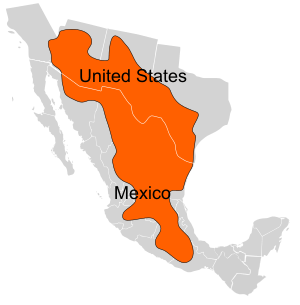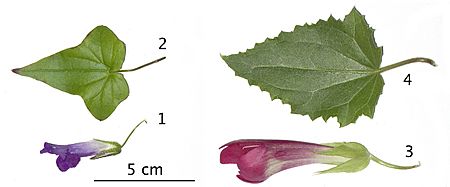Maurandya facts for kids
Quick facts for kids Maurandya |
|
|---|---|
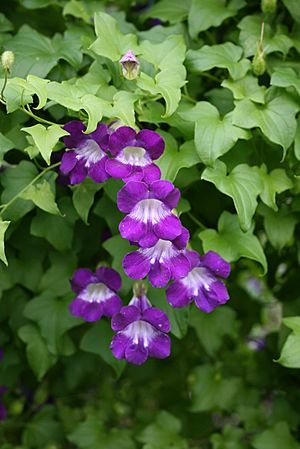 |
|
| Maurandya barclayana | |
| Scientific classification |
|
| Kingdom: | Plantae |
| Clade: | Tracheophytes |
| Clade: | Angiosperms |
| Clade: | Eudicots |
| Clade: | Asterids |
| Order: | Lamiales |
| Family: | Plantaginaceae |
| Tribe: | Antirrhineae |
| Genus: | Maurandya Ortega |
| Species | |
|
See text |
|
| Synonyms | |
|
|
Maurandya is a group of flowering plants that grow in Mexico and the southwestern United States. You can find them from California all the way to central Texas. These plants are known for sprawling or climbing, using their leaf stalks to twine around things. One of the four main types, called Maurandya barclayana, is very popular and grown in many gardens as a beautiful ornamental plant.
Sometimes, people misspell the name as Maurandia. Also, two of its species have sometimes been placed in other plant groups, like Epixiphium and Maurandella.
Contents
What Maurandya Plants Look Like
Maurandya plants are usually herbaceous perennials. This means they are non-woody plants that live for more than two years. They have roots that spread out like fibers. One type, M. wislizeni, is an annual plant, meaning it lives for only one growing season. This type has a single main root called a tap root.
All Maurandya plants either sprawl along the ground or climb. They climb by wrapping their leaf stalks (petioles) around other plants or structures. Their leaves often look like broad or narrow arrowheads. Sometimes, they can even be heart-shaped.
Flowers and Seeds
The flowers grow on stalks that point upwards. Each stalk usually has just one flower. The flower has triangular parts called sepals at its base. These sepals are not joined together, but they form a cup-like shape around the bottom of the flower.
The colorful parts of the flower are the petals, which together are called the corolla. The petals are joined at the bottom to form a tube. At the top, they have five free lobes, or sections. Two of these lobes usually curve backward, and three usually point forward. The corolla is often whitish at the very bottom, then changes to pink, red, violet, blue, or a mix of these colors.
In one species, M. antirrhiniflora, the flowers have two "lips" that partly close the opening of the flower tube. The other species have an open flower tube. Inside the flower, there are four working stamens, which are the parts that produce pollen. There's also a tiny, non-working stamen. After the flower is pollinated, it forms a two-part capsule. This capsule holds dark brown seeds.
Plant Names and Family Tree
The first Maurandya species described by scientists was Maurandya scandens. This happened in 1793, thanks to Antonio José Cavanilles, who studied plants growing in Spain. He first named it Usteria scandens. However, the name Usteria had already been used for another plant in 1790, so it couldn't be used again.
In 1797, Casimiro Gómez Ortega gave the plant its proper name, Maurandya. A year later, another scientist accidentally misspelled it as Maurandia. The name Maurandya was chosen to honor Catherina Pancratia Maurandy. She was the wife of a Spanish botany professor and helped him with his plant studies.
Maurandya belongs to a group of plants called the Antirrhineae tribe. Within this tribe, it is closely related to other plant groups like Lophospermum, Mabrya, and Rhodochiton. Scientists have sometimes grouped Lophospermum and Rhodochiton together with Maurandya. The group Mabrya was separated from Maurandya by a scientist named Wayne J. Elisens. It can be a bit confusing because names within these groups have sometimes been mixed up!
How Scientists Study Plant Relationships
Scientists use special studies, often looking at the DNA of plants, to figure out how different plant groups are related. These studies have shown that a group called Maurandyinae, which includes Holmgrenanthe, Lophospermum, Mabrya, Maurandya, and Rhodochiton, are all closely related. They also found that these North American plants are related to some older plant groups from other parts of the world, like Cymbalaria and Asarina.
Scientists believe that the Antirrhineae plant group first appeared in the "Old World" (Europe, Asia, Africa). Later, they spread to North America more than once, probably during a time called the Miocene epoch. One of these journeys led to the development of the Maurandyinae group in North America.
Types of Maurandya Species
As of July 2014, there are four types of Maurandya species that scientists agree on:
- Maurandya antirrhiniflora
- Maurandya barclayana
- Maurandya scandens
- Maurandya wislizeni
The flowers of M. antirrhiniflora are partly closed, unlike the open flowers of the other species. Because of this, some experts thought it should be in its own separate group, Maurandella. However, scientist Elisens believes the differences are not big enough to separate it.
M. wislizeni is also a bit different from the others. For example, it's the only annual plant that grows from a tap root. Some experts have placed it in a separate group called Epixiphium. But Elisens, after studying the whole group, decided that all four species are very similar overall. He still puts M. wislizeni in its own special subgroup within Maurandya.
Where Maurandya Plants Grow
Maurandya plants naturally grow in Mexico and the southwestern United States. This includes areas from California, through Arizona and New Mexico, to central Texas.
The most common species, M. antirrhiniflora, can be found in many different places. It grows in sandy soils near the coast, in rocky areas with limestone, and from sea level up to about 8,500 feet (2,600 meters) high.
The other three species live in more specific places. M. wislizeni is an annual plant that grows in the Chihuahuan Desert. M. barclayana and M. scandens usually grow in the mountains of Mexico, at heights from about 4,900 to 7,900 feet (1,500 to 2,400 meters).
Some Maurandya species, like M. antirrhiniflora, have escaped from gardens where they were planted. They now grow wild in places like Hawaii and Florida.
How Maurandya Plants Are Pollinated
Maurandya antirrhiniflora and M. barclayana are pollinated by bees with long tongues. These bees have tongues longer than about 0.24 inches (6 mm). Flowers pollinated this way are usually white, blue, or violet. Their flower tubes are typically about 0.5 to 1.4 inches (13 to 35 mm) long.
We don't know for sure what pollinates M. wislizeni. However, its flower color and shape are similar to the others, so it's likely also pollinated by long-tongued bees. M. scandens has flowers of a similar size and shape, but they are reddish-pink. This color is usually linked to pollination by hummingbirds. It's possible that M. scandens recently changed from being pollinated by bees to being pollinated by hummingbirds.
Growing Maurandya Plants
Maurandya barclayana has been grown as a climbing plant in gardens since at least the 1800s. It was brought to England in 1825 by a man named Mr. Barclay. The Horticultural Society of London named it after Dr. Maurandy, a botany professor, and Mr. Barclay. In 1836, Joseph Paxton called it a "beautiful climber." Elisens also described it as a "particularly attractive" plant for hanging or climbing.
Maurandya scandens is also commonly grown in gardens and has even spread to grow wild. If these two species are grown close together, they can sometimes cross-pollinate and create new hybrid plants.
People often get Maurandya and Lophospermum plants confused, especially in gardens. However, you can tell them apart. Maurandya flowers are shorter than Lophospermum flowers. Also, Maurandya leaves have smooth, untoothed edges, while Lophospermum leaves are a bit hairy and have toothed edges.
You can grow these plants from seeds and treat them like annuals, meaning they live for one season. If you live in a place where it doesn't freeze, or if you protect their roots from frost, the plants can be perennials. This means they will grow back from their base after dying down in the winter. M. barclayana can survive temperatures as low as 23°F (-5°C).
See also
 In Spanish: Maurandya para niños
In Spanish: Maurandya para niños


